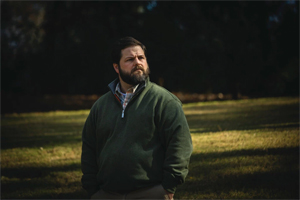by Noah Weiland
New York Times
Dec. 16, 2020
Updated 9:08 a.m. ET

Kyle McGowan, a former C.D.C. chief of staff, outside his home in Roswell, Ga., this month. He and his deputy have gone public with their disillusionment.
Audra Melton for The New York Times
Kyle McGowan, a former chief of staff at the Centers for Disease Control and Prevention, and his deputy, Amanda Campbell, were installed in 2018 as two of the youngest political appointees in the history of the world’s premier public health agency, young Republicans returning to their native Georgia to dream jobs.
But what they witnessed during the coronavirus pandemic this year in the C.D.C.’s leadership suite shook them: Washington’s dismissal of science, the White House’s slow suffocation of the agency’s voice, the meddling in its messages and the siphoning of its budget.
In interviews this fall, the pair decided to go public with their disillusionment.
“Everyone wants to describe the day that the light switch flipped and the C.D.C. was sidelined. It didn’t happen that way,” Mr. McGowan said. “It was more of like a hand grasping something, and it slowly closes, closes, closes, closes until you realize that, middle of the summer, it has a complete grasp on everything at the C.D.C.”
Last week, the editor in chief of the C.D.C.’s flagship weekly disease outbreak reports — once considered untouchable — told House Democrats investigating political interference in the agency’s work that she was ordered to destroy an email showing Trump appointees attempting to meddle with their publication.
The same day, the outlines of the C.D.C.’s future took more shape when President-elect Joseph R. Biden Jr. announced a slate of health nominees, including Dr. Rochelle Walensky, the chief of infectious diseases at Massachusetts General Hospital, as the agency’s new director, a move generally greeted with enthusiasm by public health experts.
“We are ready to combat this virus with science and facts,” she wrote on Twitter.
Mr. McGowan and Ms. Campbell — who left the C.D.C. together in August — said that mantra was what was most needed after a brutal year that left the agency’s authority crippled.
One of Ms. Campbell’s responsibilities was helping clear the agency’s Morbidity and Mortality Weekly Reports, a widely followed and otherwise apolitical guide on infectious disease renowned in the medical community. Over the summer, political appointees at the health department repeatedly asked C.D.C. officials to revise, delay and even scuttle drafts they thought could be viewed, by implication, as criticism of President Trump.
Often, Mr. McGowan and Ms. Campbell mediated between Dr. Robert R. Redfield, the C.D.C. director, and agency scientists when the White House’s requests and dictates would arrive: edits from Russell T. Vought, the White House budget director, and Kellyanne Conway, the former White House adviser, on choirs and communion in faith communities, or suggestions from Ivanka Trump, the president’s daughter and aide, on schools.
“Every time that the science clashed with the messaging, messaging won,” Mr. McGowan said.
A HAUNTING ARTIFACT: Mr. McGowan has held on to the email thread from Dec. 31, 2019, about a “cluster of pneumonia cases in Wuhan, China.”
Noah Weiland is a reporter in the Washington bureau of The New York Times, covering health care. He was raised in East Lansing, Michigan and graduated from the University of Chicago. @noahweiland

